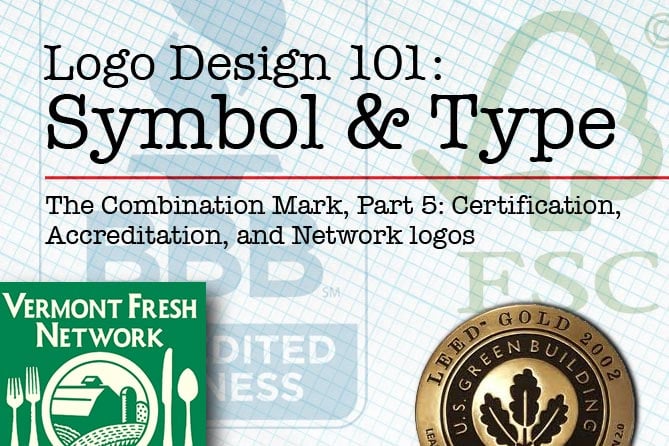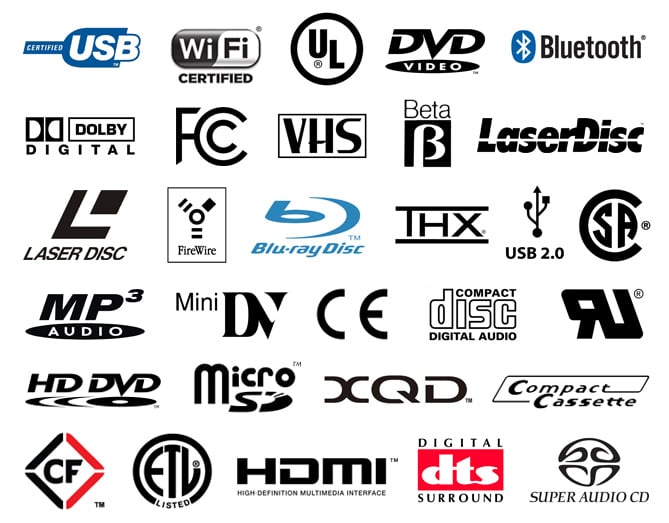
In this article, ninth in the series, Logo, Corporate Identity or Brand—What's the Difference? I want to look at certification logos and the oft-ignored (but seen everywhere) accreditation, industry standard safety, compliance and format identifier marks.
Since this series may be useful as a reference tool, here are the previous posts for easy access.
Certification, Affiliation, Network, and Accreditation Logos
With a few exceptions, logos indicating certification are typically circular or rectangular self-contained units that derive their official air from our collective history with seals and their conveyance of municipal, governmental, educational organizations' history, importance and authority. These marks that indicate certification, affiliation, or network membership have branded an idea, mission or movement. They set or raise industry standards and create an umbrella under which each member can capitalize on the consumer confidence in the larger organization of like-minded companies.
As a socially responsible marketing company that creates mission-focused strategies and change communications for our like-minded clients, not only have we used some of these marks shown below in our work, we've also worked with mission-driven companies to create new industry-standard marks.

Industry Standard Identifiers
This logo category can be overlooked since they are designed to be the relatively generic identifiers for a whole category of products. But they are identity projects with their own full set of market-driven design considerations, just like any other product or service. The irony in overlooking this category of logos, or thinking of them as relatively unimportant, is that they are EVERYWHERE. On every piece of consumer electronics, every CD jacket, DVD box, toaster, computer and Blu-Ray disc. They share a similar purpose and usage with certification logos in that they are created to tell the brand story of a product, idea, or format, then are used by many different companies that benefit from displaying a mark that assures consumers of an industry standard of consistency, quality and/or safety.
 Logos that indicate safety certification or industry standard compliance
Logos that indicate safety certification or industry standard compliance
As a ubiquitous symbol of an industry standard or format identifier, the mark must be relatively simple, communicate clearly and be instantly recognizable. Even though some of these logos are in the wordmark or type symbol category, I include them in this post because as design evolves in this industry standard/format identifier category, the marks are becoming more sophisticated, with custom typography and well-designed symbols. Besides safety certification, the main use of these marks is in identifying formats of audio, video, and digital media and transfer protocols. In order to identify the format(s), media, computer language or data transfer protocols that a piece of consumer electronics is compatible with, the format needs to be branded and the logo is applied to the hardware and the media.
Typically there are two scenarios, as I see it. 1. An international standard is set and maintained by the government, or an organization approved by the government, for example, Underwriters Laboratories. In this scenario there is often a safety mandate, for example, a UL listing assures the consumer that the product is safe from electrical problems and fire. Their laboratory, certification and testing facilities also address other safety issues that include hazardous substances, water quality, food safety, performance testing, safety and compliance education and environmental sustainability.
The second scenario: a corporation or consortium creates something that becomes an industry standard, such as Sony, Philips, Toshiba, and Panasonic inventing and developing the DVD format. Or the Blu-ray Disc Association that develops and licenses Blu-ray Disc technology, started by MIT and nine leading electronic companies: Sony, Panasonic, Pioneer, Philips, Thomson, LG Electronics, Hitachi, Sharp, and Samsung.
Competing Formats or Standards
Often there are competing formats when a new technology emerges. For example, and I'm dating myself here, VHS and Betamax fought it out for many years to be the predominant format for home video. As companies compete to become the industry standard, superior product development is definitely a goal, but marketing, naming, and design can make the difference. Although there were many players involved and a complicated series of events that made Blu-ray Disc the industry standard over HD DVD, as a designer and marketer I believe that the sexy and mysterious "Blu-ray Disc" name and logo defeated the boring and utilitarian "HD DVD." Just my observation.





